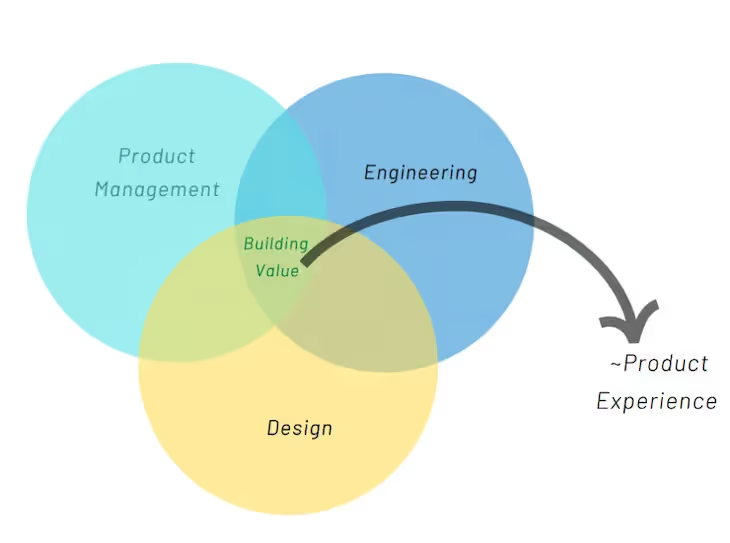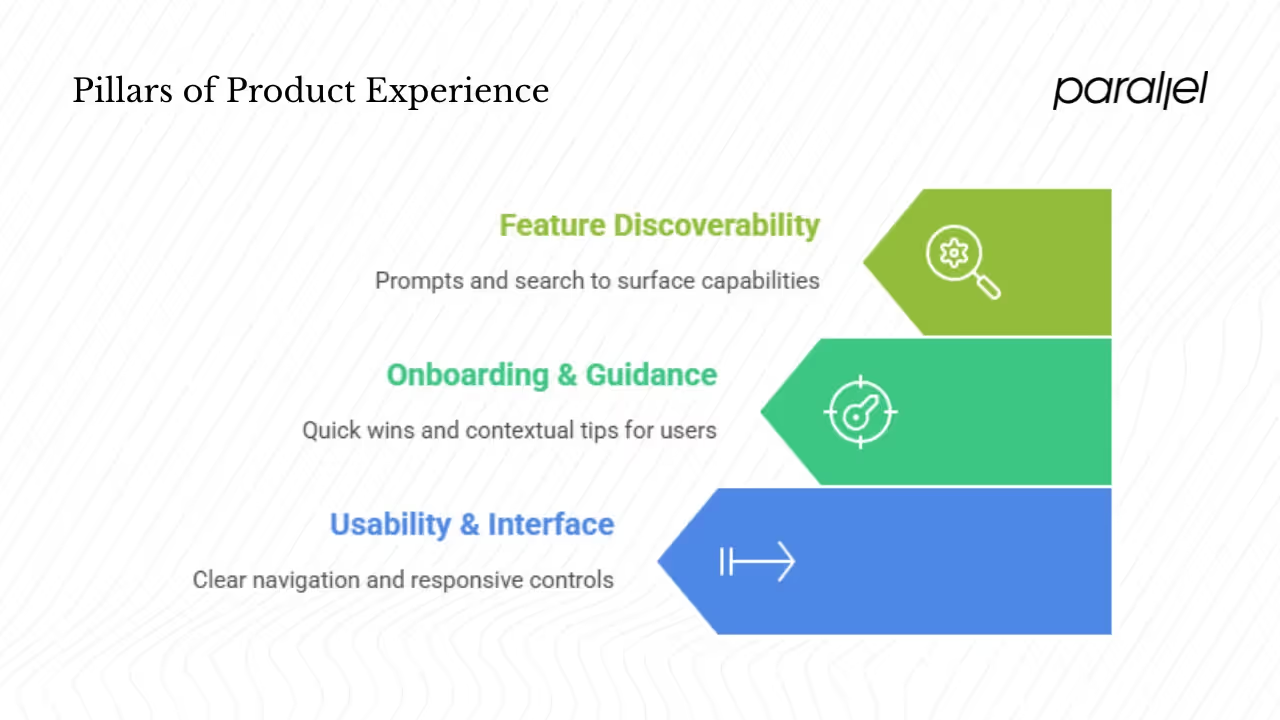What Is Product Experience? Guide (2025)
Understand product experience, the holistic perception users have when interacting with your product, and how to enhance it.

Recently I watched a new user sign up for a tool we’d built. The registration page demanded too many details and dumped them into a cluttered interface. They left within minutes. For SaaS teams relying on free trials, silent exits like this are costly because people expect software to feel helpful right away.
That story illustrates why I care about product experience. When we ask what is product experience we mean more than screens and buttons; we mean the feelings and perceptions people have from their first action to continued use. This article explains the concept, why it matters, and how to design, measure and improve it using insights from research and my work with early‑stage teams.
What product experience means?
Product experience (PX) is the sum of feelings, perceptions and interactions a person has inside your software. ZapScale describes it as the total of users’ feelings, perceptions and interactions across the entire path in an application. Fullstory adds that PX covers every interaction from first use through ongoing engagement. Unlike user experience, which focuses on individual tasks, PX considers the arc from onboarding to long‑term use and includes performance, discoverability, guidance and emotion. In my own work, I tell founders that product experience is the emotional imprint left by each click, screen and message.

Why PX matters for product‑led businesses
In product‑led models, much of the customer lifecycle happens inside the product. If the experience is clunky, users churn. Fullstory found that 90% of users abandon an app because of poor performance and 86% will leave a brand after two bad experiences. Conversely, 96% stay loyal to brands that offer great service. For SaaS companies, improving product experience boosts activation, retention and expansion without expensive marketing.
How PX relates to UX and CX
People often ask what product experience is relative to UX and CX. UX concerns usability and specific interactions. PX includes UX but looks at the entire in‑product path – sign‑up, onboarding, feature discovery, support and renewal. CX is broader still, covering marketing, sales and support. Qualtrics describes product experience as one of several experiences that shape how customers feel about what you’ve created. When thinking about brand perception, PX forms a significant part of the overall customer impression but sits alongside advertising, sales and support.
Pillars of product experience
Drawing on client work and research, I view PX as a set of pillars. Each pillar influences perception and usage. Understanding them helps answer what is product experience in practical terms. Taken together, these pillars reveal how design, guidance, performance and emotion combine to define what is product experience for your product.
1) Usability and interface
Clear navigation, consistent layout and responsive controls enable users to complete tasks quickly. Progress indicators reduce anxiety and friendly error messages help people recover. Micro‑interactions like button animations and confirmation toasts make the product feel responsive.
2) Onboarding and guidance
The first session should guide users toward a quick win. Contextual tips, guided tours and progressive disclosure introduce concepts without overwhelming. ZapScale notes that automated walkthroughs and personalised in‑app instructions can reduce churn. Measure activation rate and time to first value to see if onboarding works. Product School reports that 74% of people abandon products with complicated onboarding.
3) Feature discoverability and focus
Many features go unused because users never see them. Product School notes that about 53% of SaaS licences are unused. Consider feature discoverability part of the experience. Use prompts, search and clear information architecture to surface important capabilities. Cut or hide unused features and focus development on the ones users value.

Other pillars
Reliability and performance come next: fast load times, stable sessions and data integrity build trust, and research shows that 90% of users abandon an app after poor performance. Personalisation helps by adapting the interface based on user behaviour, but it must be transparent and respectful. Emotional tone matters too; Qualtrics notes that product experience includes visual appeal and emotional response, so friendly language, small celebrations and trust signals like security indicators make people feel safe and valued. Engagement loops such as reminders, progress trackers and badges encourage repeated use when tied to real goals. Feedback tools including surveys, session recordings and heatmaps reveal friction; Fullstory stresses acting on feedback to improve PX. Finally, maintain brand consistency across channels so the product feels like part of the same company and people know what to expect.
The user path inside the product
Mapping the user path helps teams understand what product experience is in action. Users move through several phases: sign‑up should set clear expectations with minimal friction; the first session aims to deliver an early win by guiding them to the action that creates value; exploration encourages trying more features through gentle prompts; habit building relies on reminders and celebrations to keep people coming back; expansion invites upgrades when users see benefit from core capabilities; and churn requires watching for disengagement and running thoughtful win‑back campaigns. Each phase deserves attention and measurement so that users advance smoothly instead of drifting away.
Benefits of investing in PX
Why care about product experience? For founders and product leaders, there are several benefits:
- Higher satisfaction and loyalty: A polished product reduces friction. Fullstory reports that 96% of customers remain loyal to brands that offer great service.
- Stronger engagement: Clear flows and valuable features encourage frequent use and deeper adoption. Engagement loops build habits and increase lifetime value.
- Better return on development: Removing unused features and focusing on what users value saves resources. Product School’s statistic that 53% of SaaS licences go unused highlights the cost of building features people don’t use.
- Differentiation: When competitors offer similar functionality, experience becomes the differentiator. Fullstory notes that 74% of consumers base purchasing decisions on product experience.
- Brand trust: A reliable, thoughtful product reflects well on your company. Qualtrics emphasises that emotional response to a product influences brand perception.
Measuring and improving PX
Effective product experience work blends data with human insight. Here are practical ways to measure and improve PX.
Important metrics
- Activation and time to first value: measure how many new users complete the first meaningful action and how long it takes to reach an early success.
- Feature adoption and engagement depth: track what percentage of users use each feature, how often and for how long.
- Retention and cohorts: analyse how many users return over time and segment by behaviour.
- Error and crash rates: monitor performance issues and their impact on churn.
- Promoter and satisfaction scores: metrics like Net Promoter Score (NPS) and Customer Satisfaction (CSAT) capture willingness to refer and overall satisfaction.
Qualitative methods
Numbers tell what is happening; qualitative research reveals why. Conduct interviews, usability tests and contextual inquiries. Watch session replays and heatmaps to see where people hesitate, and ask targeted questions in surveys. Time feedback prompts thoughtfully to improve response rates.
Tools
Analytics platforms such as Amplitude or Mixpanel track events and cohorts. Feedback modules from companies like Sprig, Pendo or Intercom capture sentiment inside the product. Session replay tools like Fullstory show exactly what users do, and product experience management suites aim to combine analytics and feedback in one system.
Working process
PX is a team effort. Share goals and metrics across product, design, engineering and support. Work in cycles: identify issues, test ideas and iterate based on data. Focus on improvements with the greatest impact and fold PX into long‑term planning rather than treating it as a one‑off project.
Maturity stages
- Early stage: remove friction in basic flows, improve sign‑up and onboarding, and track activation and churn.
- Growth stage: build feedback loops, personalise experiences and refine feature discovery.
- Advanced stage: use predictive analytics and adaptive interfaces to anticipate user needs and adjust flows in real time.
Examples from practice
Stories bring the definition of what is product experience to life. Here are two examples.
Duolingo’s rename to product experience
In March 2025 Duolingo rebranded its UX team as “Product Experience.” Mig Reyes said the change reflected a shift from designing screens to shaping the entire flow. The team now considers how sign‑up, lessons, streaks and upsells fit together, which has helped keep learners engaged and convert free users into paying subscribers.

Cleaning up onboarding
In a client project, a data tool asked new users to fill twelve fields before entering the product. Session recordings showed drop‑offs, so we cut the fields to three, added a progress indicator and inserted a short tutorial pointing to the first valuable action. Activation rose from 40% to 65% and support tickets fell, showing how small changes early on can have outsize effects.
Common pitfalls
- Too many features: extra capabilities clutter interfaces and confuse users. Focus on value.
- Over‑personalisation: customisation can feel invasive. Be clear about data use and let people opt out.
- Ignoring accessibility: design for different abilities and workflows, not just the average user.
- Focusing on surface over substance: attractive visuals can’t compensate for crashes and slow performance.
- Collecting feedback without acting: users stop sharing if nothing changes.
- Team silos: misalignment between product, design and engineering leads to inconsistent experiences.
Playbook for improvement
- Audit paths: map sign‑up and core flows with analytics and session replays to find friction.
- Prioritise and prototype: tackle the biggest obstacles first, often onboarding or navigation, and test ideas with real users.
- Instrument and experiment: set up metrics for activation, adoption and retention, and run A/B tests to learn what works.
- Evaluate and share: compare results, adjust and spread insights across teams.
- Create a feedback habit: make it easy for users and colleagues to share insights and respond to them.
- Scale personalisation: as you grow, use data and predictive models to adapt interfaces while respecting privacy.
Emerging directions
Predictive personalisation
Machine learning will allow products to adapt to behaviour, time of day and context. A budgeting app could surface different dashboards on payday versus mid‑month, offering more relevant guidance while raising privacy questions.
Embedded assistance
Context‑aware helpers will move past static tooltips. Conversational assistants that understand user intent can answer questions or walk someone through a task without leaving the product.
Conclusion
So what is product experience? It’s the emotional and functional path users follow inside your software. In a market where people can switch tools in seconds, the way your product feels is as important as what it does. Start by mapping the path, removing friction and delivering value fast. Measure activation, adoption and retention, listen to feedback and iterate. Investing in product experience is an ongoing commitment that pays off in loyalty, advocacy and long‑term success.
Frequently asked questions (FAQ)
1) What are examples of product services?
In software, product services include premium support, training, analytics or integration modules and paid features. In hardware‑plus‑software products, services can include predictive maintenance or cloud connectivity. These add-ons extend the product’s value.
2) What is the total product experience?
It refers to the overall impression across product, service and brand touchpoints. Product experience management platforms aim to manage these aspects.
3) What is the difference between user experience and product experience?
User experience focuses on single interactions, while product experience covers the whole path from sign‑up through renewal and includes performance, discoverability, guidance and emotional layers.
4) What is the difference between customer experience and product experience?
Customer experience includes all interactions with a company – marketing, sales, support and product. Product experience is the in‑product portion, and weak PX drags down overall perception.


.avif)










